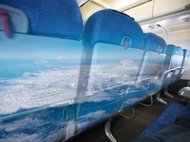
FLYING 4.0 – WHAT WILL AIR TRAVEL BE LIKE IN 2050?
VR-HYPERSPACE IMPROVES PASSENGER COMFORT IN CRAMPED AIRCRAFT CABINS
TRANSPARENT INTERIOR AIRPLANE AND TROPICAL BEACHES AT THE PUSH OF A BUTTON
As part of the project, Fraunhofer IAO has developed a mock-up of an aircraft cabin in which the plane’s shell can be switched to “see-through mode”. Passengers bothered by the seats in front can choose to make these transparent, too. Of course, this is possible only in a virtual sense: all the seat backrests are entirely covered in displays, with flat-screen televisions built into the floor and 14 projectors for projecting images onto the cabin walls. Effectively, the whole cabin is a display. Combined with a head tracking system, this lets passengers think they’re not in a plane but on a magic carpet! For those who are scared of heights or nervous about flying, the displays can naturally also show other scenes, such as a tropical island or a stream running through a forest. Any passengers with work to do can run current Office applications on the built-in display system, all the while enjoying the (virtual) sunshine of their own desert island. Initial results indicate that the scenarios developed so far enable test subjects to put up with a lack of comfort for longer and feel that time flies by more quickly.
VIRTUAL REALITY CREATES SPACE - The illusion of more space and comfort
The Max Planck Institute for Biological Cybernetics tests scientific outcomes on self and space perception during in-flight motions, .i.e. turbulence. The first results using fully tracked and immersive head-mounted-displays¹ demonstrate that one can experience presence in a larger space (i.e. a beach), experience an altered virtual body (i.e a more comfortable posture²) and that the experience of the body size influences the perception of space. The question for the final months is if these positive illusions occur under flight conditions and/or can alleviate stress caused by experiencing turbulence in-flight? For demonstration the head-mounted display positive illusion experiences, physiological and behavioral measuring technology and the CyberMotion Simulator for simulation of turbulence are combined. The CyberMotion Simulator is a novel all-purpose motion simulator that provides scientists the unique opportunity to test future scenarios of using virtual reality in flight while observing their behavior.
¹ glasses allowing to perceive a spacious virtual 3D-scene m
² project in cooperation with Prof. Mel Slater, Universitat de Barcelona
